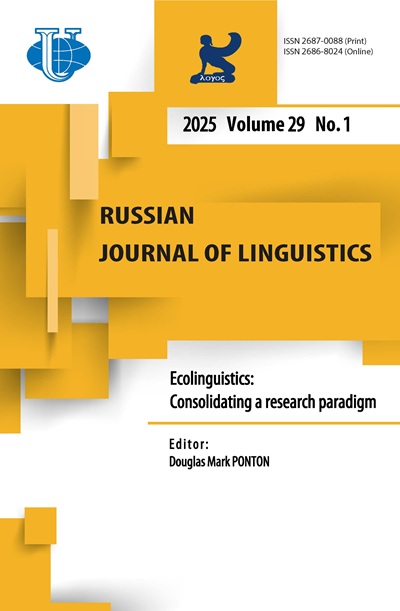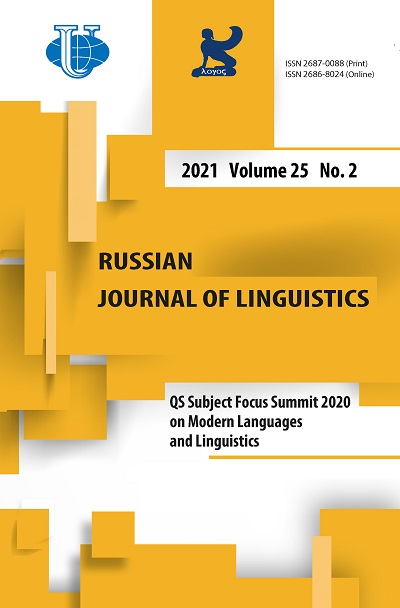«No» и «нет» как ответные единицы в английском и русском деловом дискурсе: в поисках функциональной эквивалентности
- Авторы: Малюга Е.Н.1, МакКарти М.2
-
Учреждения:
- Российский университет дружбы народов
- Ноттингемский университет
- Выпуск: Том 25, № 2 (2021): QS саммит 2020 по предметным областям «Современные языки» и «Лингвистика»
- Страницы: 391-416
- Раздел: Статьи
- URL: https://journals.rudn.ru/linguistics/article/view/26798
- DOI: https://doi.org/10.22363/2687-0088-2021-25-2-391-416
Цитировать
Полный текст
Аннотация
Согласно исследованиям, в английском языке частица no , используемая в начале реплики, выполняет широкий спектр дискурсивно-прагматических функций, помимо отрицательного реагирования на полярные вопросы. При этом нет оснований утверждать, что ее ближайший русский эквивалент нет обладает идентичной дистрибуцией и таким же набором функций. В связи с этим исследование контрастирующих и схожих черт в номенклатуре и распределении функций no и нет представляется важной исследовательской проблемой применительно к различным дискурсам, особенно к деловому дискурсу, ориентированному на целеполагание и продуктивные межличностные отношения, требующие адекватного межязыкового взаимодействия. В данной статье анализируется употребление no и нет в разговорном деловом/ профессиональном дискурсе с целью установления их функциональной сопоставимости и выявления различий в их употреблении. Источниками материала послужили Кембриджский и Ноттингемский корпус разговорного делового английского языка и Национальный корпус русского языка. В процессе исследования применялись метод корпусной лингвистики, конверсационный анализ и дискурс-анализ. Проведенное исследование позволило выявить как сходства, так и различия между функциями отрицательных ответных единиц в английском и русском языках. Было установлено, что в обоих языках рассматриваемые единицы реализуют ряд функций, связанных с непрерывностью коммуникативного взаимодействия, управлением темой разговора, меной коммуникативных ролей и хеджированием. Распределение и функции no/нет в сопоставляемых базах данных схожи, при этом в русском языке предпочтение отдается перехвату коммуникативного хода с использованием нет как вступительного элемента реплики. Эквивалентность перевода no и net не всегда достижима в полном объеме. Использованная в статье смешанная методика позволила получить результаты, продуктивные с точки зрения возможностей компаративного анализа корпусных данных делового английского и делового русского языков. Полученные данные и выводы открывают возможности для дальнейшего анализа употребления no и нет в английском и русском деловых дискурсах.
Об авторах
Елена Н. Малюга
Российский университет дружбы народов
Автор, ответственный за переписку.
Email: malyuga-en@rudn.ru
ORCID iD: 0000-0002-6935-0661
профессор лингвистики, заведующая кафедрой иностранных языков экономического факультета Российского университета дружбы народов, доктор филологических наук, председатель Национального объединения преподавателей иностранных языков делового и профессионального общения в сфере бизнеса (Россия), главный редактор журналов «Вопросы прикладной лингвистики» и «Training, Language and Culture». Научные интересы: теория и практика межкультурного профессионального и делового общения, прагматика, корпусные исследования, дискурс-анализ. Автор/соавтор более 300 публикаций.
Россия, 117198, Москва, Миклухо-Маклая, 6Майкл МакКарти
Ноттингемский университет
Email: mactoft@aol.com
ORCID iD: 0000-0001-6795-3816
почетный профессор прикладной лингвистики Ноттингемского университета (Великобритания), адъюнкт-профессор прикладной лингвистики Лимерикского университета (Ирландия), приглашенный профессор прикладной лингвистики в Университете Ньюкасла (Великобритания) и Российском университете дружбы народов. Он является (со)автором и (со)редактором 56 книг, в том числе “Spoken Language and Applied Linguistics”, “The Cambridge Grammar of English”, “From Corpus to Classroom: Language Use and Language Teaching” и “The Routledge Handbook of Corpus Linguistics”. Автор/соавтор 120 научных работ, в которых основное внимание уделяется разговорной речи. Соучредитель (совместно с Рональдом Картером) корпуса разговорного английского языка “CANCODE” и корпуса разговорного делового английского языка “CANBEC”.
Ноттингем, ВеликобританияСписок литературы
- Aijmer, Karin & Bengt Altenberg. 2013. Introduction. In Karin Aijmer & Bengt Altenberg (eds.), Advances in corpus-based contrastive linguistics: Studies in honour of Stig Johansson, 1-6. Amsterdam: John Benjamins
- Apresjan, Valentina Ju. 2015. Concessivity: Mechanisms of Formation and Interaction of Complex Meanings in the Language. Moscow: Languages of Slavic Cultures
- Bald, Wolf-Dietrich. 1980. Some functions of “yes” and “no” in conversation. In Sidney Greenbaum, Geoffrey Leech & Jan Svartvik (eds.), Studies in English linguistics for Randolph Quirk, 179-191. London: Longman
- Beeching, Kate. 2013. A parallel corpus approach to investigating semantic change. In Karin Aijmer & Bengt Altenberg (eds.), Advances in corpus-based contrastive linguistics: Studies in honour of Stig Johansson, 103-125. Amsterdam: John Benjamins
- Biber, Douglas, Stig Johansson, Geoffrey Leech, Susan Conrad & Edward Finegan. 1999. Longman Grammar of Spoken and Written English. London: Longman
- Brasoveanu, Adrian, Donka Farkas & Floris Roelofsen. 2013. N-words and sentential negation: Evidence from polarity particles and VP ellipsis. Semantics and Pragmatics 6. 1-33. DOI: https://doi.org/10.3765/sp.6.7
- Burridge, Kate & Margaret Florey. 2002. “Yeah-no he’s a good kid”: A discourse analysis of “yeah-no” in Australian English. Australian Journal of Linguistics 22 (2). 149-171. DOI: https://doi.org/10.1080/0726860022000013166
- Collins, Peter. 2012. Australian English: Its evolution and current state. International Journal of Language, Translation and Intercultural Communication 1 (1). 75-86. DOI: https://doi.org/10.12681/ijltic.11
- Connor, Ulla M. & Ana I. Moreno 2005. Tertium Comparationis: A vital component in contrastive research methodology. In Paul Bruthiaux, Dwight Atkinson, William G. Eggington, William Grabe & Vaidehi Ramanathan (eds.), Directions in Applied Linguistics: Essays in Honor of Robert B. Kaplan, 153-164. Clevedon: Multilingual Matters
- Couper-Kuhlen, Elizabeth & Margret Selting. 2018. Interactional Linguistics: Studying Language in Social Interaction. Cambridge: Cambridge University Press
- Egan, Thomas. 2013. “Tertia comparationis” in multilingual corpora. In Karin Aijmer & Bengt Altenberg (eds.), Advances in corpus-based contrastive linguistics: Studies in honour of Stig Johansson, 7-24. Amsterdam: John Benjamins
- Fries, Charles C. 1952. The Structure of English: An Introduction to the Construction of English Sentences. New York: Harcourt, Brace and Company
- Gribanova, Tatiana I. & Tamara M. Gaidukova. 2019. Hedging in different types of discourse. Training, Language and Culture 3 (2). 85-99. DOI: https://doi.org/10.29366/2019tlc.3.2.6
- Handford, Michael. 2010. The language of Business Meetings. Cambridge: Cambridge University Press
- Heritage, John. 2002. Oh-prefaced responses to assessments: A method of modifying agreement/disagreement. In Cecilia E. Ford, Barbara A. Fox & Sandra A. Thompson (eds.), The Language of turn and sequence, 196-224. New York: Oxford University Press
- Heritage, John & Marja-Leena Sorjonen. (eds.). 2018. Between Turn and Sequence: Turn-Initial Particles Across Languages. Amsterdam/Philadelphia: John Benjamins Publishing Company. DOI: https://doi.org/10.1075/slsi.31
- Iliadi, Paraskevi-Lukeriya L. & Tatiana V. Larina. 2017. Refusal strategies in English and Russian. RUDN Journal of Language Studies, Semiotics and Semantics 8 (3). 531-542. DOI: https://doi.org/10.22363/2313-2299-2017-8-3-531-542
- Jefferson, Gail. 2002. Is “no” an acknowledgment token? Comparing American and British uses of (+)/(-) tokens. Journal of Pragmatics 34 (10-11). 1345-1383. DOI: https://doi.org/10.1016/S0378-2166(02)00067-X
- Johansson, Stig & Knut Hofland. 1994. Towards an English-Norwegian parallel corpus. In Udo Fries, Gunnel Tottie & Peter Schneider (eds.), Creating and using English language corpora, 25-37. Zürich: Rodopi
- Krzeszowski, Tomasz P. 1984. Tertium comparationis. In Jacek Fisiak (ed.), Contrastive Linguistics: Prospects and Problems, 301-312. Berlin: Mouton Publishers.
- Lee-Goldman, Russell. 2011. “No” as a discourse marker. Journal of Pragmatics 43 (10). 2627-2649. DOI: https://doi.org/10.1016/j.pragma.2011.03.011
- Lewis, Richard. 2019. The cultural imperative: Global trends in the 21st century. Training, Language and Culture 3 (3). 8-20. doi: 10.29366/2019tlc.3.3.1
- Malyuga, Elena N. & Michael McCarthy. 2018. English and Russian vague category markers in business discourse: Linguistic identity aspects. Journal of Pragmatics 135. 39-52. DOI: https://doi.org/10.1016/j.pragma.2018.07.011
- Malyuga, Elena N., Alex Krouglov & Barry Tomalin. 2018. Linguo-cultural competence as a cornerstone of translators’ performance in the domain of intercultural business communication. XLinguae 11(2). 566-582. doi: 10.18355/XL.2018.11.02.46
- Malyuga, Elena N. & Barry Tomalin. 2014. English professional jargon in economic discourse. Journal of Language and Literature 5(4). 172-180. doi: 10.7813/jll.2014/ 5-4/38
- Malyuga, Elena N., Alexander Shvets & Ilyia Tikhomirov. 2016. Computer-based analysis of business communication language. In Proceedings of 2016 SAI Computing Conference, SAI 2016, 229-232
- McCarthy, Michael. 2002. Good listenership made plain: British and American non-minimal response tokens in everyday conversation. In Randi Reppen, Susan M. Fitzmaurice & Douglas Biber (eds.), Using corpora to explore linguistic variation, 49-71. Amsterdam: John Benjamins Publishing. DOI: https://doi.org/10.1075/scl.9.05mcc
- McCarthy, Michael. 2003. Talking back: “Small” interactional response tokens in everyday conversation. Research on Language and Social Interaction 36 (1). 33-63. DOI: https://doi.org/10.1207/S15327973RLSI3601_3
- McGee, Peter. 2018. Vague language as a means of avoiding controversy. Training, Language and Culture 2 (2). 40-54. DOI: https://doi.org/10.29366/2018tlc.2.2.3
- Mikhailov, Mikhail & Robert Cooper. 2016. Corpus Linguistics for Translation and Contrastive Studies. Abingdon/Oxon: Routledge
- O’Keeffe, Anne & Svenja Adolphs. 2008. Using a corpus to look at variational pragmatics: Response tokens in British and Irish discourse. In Klaus P. Schneider & Anne Barron (eds.), Variational Pragmatics, 69-98. Amsterdam: John Benjamins Publishing
- Pope, Emily N. 1976. Questions and Answers in English. The Hague: Mouton
- Quirk, Randolph, Sidney Greenbaum, Geoffrey Leech & Jan Svartvik. 1985. A Comprehensive Grammar of the English Language. London: Longman
- Raymond, Geoffrey. 2003. Grammar and social organization: Yes/no interrogatives and the structure of responding. American Sociological Review 68 (6). 939-967. DOI: https://doi.org/10.2307/1519752
- Sacks, Harvey, Emanuel A. Schegloff & Gail Jefferson. 1974. A simplest systematics for the organization of turn-taking for conversation. Language 50 (4). 696-735. DOI: https://doi.org/10.1353/lan.1974.0010
- Schegloff, Emanuel A. 1982. Discourse as interactional achievement: Some uses of “uh huh” and other things that come between sentences. In Deborah Tannen (ed.), Analysing discourse: Text and talk, 71-93. Washington: Georgetown University Press
- Schegloff, Emanuel A. 1992. Repair after next turn: The last structurally provided defense of intersubjectivity in conversation. American Journal of Sociology 97 (5). 1295-1345. DOI: https://doi.org/10.1086/229903
- Schegloff, Emanuel A. 1996. Turn organization: One intersection of grammar and interaction. In Elinor Ochs, Emanuel A. Schegloff & Sandra A. Thompson (eds.), Interaction and grammar, 52-133. Cambridge: Cambridge University Press
- Schegloff, Emanuel A. 2001. Getting serious: Joke → serious “no”. Journal of Pragmatics 33 (12). 1947-1955. DOI: https://doi.org/10.1016/S0378-2166(00)00073-4
- Stivers, Tanya. 2004. “No no no” and other types of multiple sayings in social interaction. Human Communication Research 30 (2). 260-293. DOI: https://doi.org/10.1111/j.1468-2958.2004.tb00733.x
- Tao, Hongyin. 2003. Turn initiators in spoken English: A corpus-based approach to interaction and grammar. In Pepi Leistyna & Charles F. Meyer (eds.), Corpus analysis: Language structure and language use, 187-207. Amsterdam/New York: Rodopi. DOI: https://doi.org/10.1163/9789004334410_011
- Thompson, Sandra A., Barbara A. Fox & Elizabeth Couper-Kuhlen. 2015. Grammar in Everyday Talk: Building Responsive Actions. Cambridge: Cambridge University Press
- Tottie, Gunnel. 1991. Conversational style in British and American English: The case of backchannels. In Karin Aijmer & Bengt Altenberg (eds.), English corpus linguistics, 254-271. London: Longman
- Wong, Jock Onn. 2018. The semantics of logical connectors: Therefore, moreover and in fact. Russian Journal of Linguistics 22 (3). 581-604. DOI: https://doi.org/10.22363/2312-9182-2018-22-3-581-604
- Zalizniak, Anna A. & Elena V. Paducheva. 2018. Towards a semantic analysis of Russian discourse markers: Pozhaluj, nikak, vsjo-taki. Russian Journal of Linguistics 22 (3). 628-652. DOI: https://doi.org/10.22363/2312-9182-2018-22-3-628-652

















